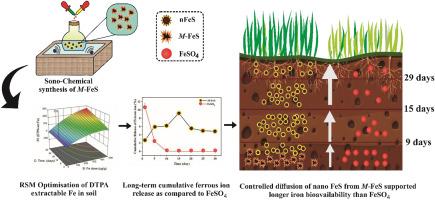Iron sulfide nano-meerschaum composite (M-FeS) prolonged the release of bioavailable iron: Optimising accessibility, release kinetics and uptake in direct seeded rice under alkaline stress
IF 3.8
Q2 BIOTECHNOLOGY & APPLIED MICROBIOLOGY
引用次数: 0
Abstract
Iron bioavailability is a persistent challenge for sensitive crops such as rice which is usually exacerbated by electrochemical reactivity and rapid oxidation of iron, further aggravated under alkaline-stress. Sustainable alternatives are mandated over traditional practices to augment iron uptake, under which, the study leveraged the nanotechnological and chemical modification of iron as iron sulfide nano-meerschaum composite (M-FeS). M-FeS was prepared, characterized and statistically optimized by Response surface methodology (RSM) in alkaline loamy sand soil (pH 8.7) for maximum extractable Fe, subjected to varying organic matter (1.82–5 %), iron doses (5–500 μg/g) and incubation times (0–30 days). The soil incubation at an optimized dose of M-FeS (473.34 μg/g) presented extractable Fe at 54.72 %, with 39.31 % in bioavailable ferrous form, sustained over 29.47 days. In contrast, FeSO4, optimized at 495.04 μg/g, achieved 64.1 % extractable Fe over 8.9 days with only 13.5 % in ferrous form. The Higuchi model was the best fit of release kinetic model indicating a Fickian diffusion-controlled mechanism facilitating sustained ferrous ion availability in alkaline soils. Direct-seeded rice (DSR) grown under pot studies in M-FeS treated soil showed significantly higher corrected iron uptake of 15.38 % in shoots and 28.56 % in roots relative to 5.45 % and 6.85 %, respectively, under FeSO4 treatment on day 29. M-FeS, thus, represented a prolonged-release iron fertilizer, promoting sustainable agriculture through improved iron delivery in DSR under alkaline stress.

硫化铁纳米复合材料(M-FeS)延长了生物可利用铁的释放:碱胁迫下直接播种水稻的可及性、释放动力学和吸收优化
铁的生物利用度是水稻等敏感作物面临的一个持续挑战,通常会因电化学反应性和铁的快速氧化而加剧,在碱胁迫下进一步加剧。与传统做法相比,可持续替代方案被强制要求增加铁的吸收,在此基础上,该研究利用纳米技术和铁的化学改性作为硫化铁纳米meerschaum复合材料(M-FeS)。采用响应面法(RSM)在pH为8.7的碱性壤土中制备了M-FeS,并对其进行了表征和统计优化,以获得最大铁提取率,受不同有机质(1.82 - 5%)、铁剂量(5-500 μg/g)和培养时间(0-30 d)的影响。在最佳M-FeS浓度(473.34 μg/g)下,土壤可提取铁含量为54.72%,生物可利用铁含量为39.31%,持续时间为29.47 d。相比之下,优化浓度为495.04 μg的FeSO4在8.9 d内获得了64.1%的铁,而亚铁的提取率仅为13.5%。Higuchi模型最适合于释放动力学模型,表明Fickian扩散控制机制促进了碱性土壤中亚铁离子的持续有效性。盆栽直接播种稻(DSR)在M-FeS处理土壤上的校正铁吸收量显著高于第29天FeSO4处理下的5.45%和6.85%,分别为15.38%和28.56%。因此,M-FeS是一种长效铁肥,通过改善碱性胁迫下DSR的铁输送,促进农业可持续发展。
本文章由计算机程序翻译,如有差异,请以英文原文为准。
求助全文
约1分钟内获得全文
求助全文
来源期刊

Biocatalysis and agricultural biotechnology
Agricultural and Biological Sciences-Agronomy and Crop Science
CiteScore
7.70
自引率
2.50%
发文量
308
审稿时长
48 days
期刊介绍:
Biocatalysis and Agricultural Biotechnology is the official journal of the International Society of Biocatalysis and Agricultural Biotechnology (ISBAB). The journal publishes high quality articles especially in the science and technology of biocatalysis, bioprocesses, agricultural biotechnology, biomedical biotechnology, and, if appropriate, from other related areas of biotechnology. The journal will publish peer-reviewed basic and applied research papers, authoritative reviews, and feature articles. The scope of the journal encompasses the research, industrial, and commercial aspects of biotechnology, including the areas of: biocatalysis; bioprocesses; food and agriculture; genetic engineering; molecular biology; healthcare and pharmaceuticals; biofuels; genomics; nanotechnology; environment and biodiversity; and bioremediation.
 求助内容:
求助内容: 应助结果提醒方式:
应助结果提醒方式:


